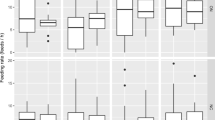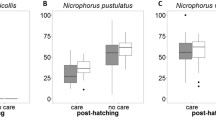Summary
We investigated the division of labor in male and female tree swallows by measuring the rate of food delivery to nestlings at 36 nests. By observing natural nests and performing brood manipulations we found that males and females divided the feeding duties about equally and responded similarly to changes in brood size and age. Feeding rate was most highly correlated with brood mass. Manipulation and removal experiments showed that increased feeding rates could be elicited, but only for limited periods of time. Male and female tree swallows could only partially compensate in feeding nestlings when mates were removed. This, along with the higher mortality in enlarged broods and in those raised by single parents, indicates that both male and female are required to raise an entire brood to fledging. We argue that this requirement contributes to the absence of mate guarding and the maintenance of monogamy in the tree swallow.
Similar content being viewed by others
References
Allen RW, Nice MM (1952) A study of the breeding biology of the purple martin (Progne subis). Am Midl Nat 47:605–665
Ball GF (1982) Anisogamy and the sexual division of parental care in barn swallows (Hirundo rustica). Abstract, 100th Annual Meeting of the American Ornithologists Union
Beer CG (1963) Incubation and nest building behaviour of black-headed gulls. III. The pre-laying period. Behaviour 21:13–77
Best LB (1977) Nestling biology of the field sparrow. Auk 94:308–319
Biermann GC, Sealey SG (1982) Parental feeding of nestling yellow warblers in relation to brood size and food availability. Auk 99:332–341
Bryant DM, Westerterp KR (1980) The energy budget of the house martin Delichon urbica. Ardea 68:91–102
Burger J (1981) Sexual differences in parental activities of breeding black skimmers. Am Nat 117:975–984
Coulson JC, Wooler RD (1976) Differential survival rates among breeding kittiwake gulls Rissa tridactyla. J Anim Ecol 45:205–213
De Steven D (1980) Clutch size, breeding success, and parental survival in the tree swallow Iridoprocne bicolor. Evolution 34:278–291
Finlay JC (1971) Breeding biology of purple martins at the northern limit of their range. Wilson Bull 83:255–269
Gibb J (1955) Feeding rates of great tits. Br Birds 48:49–58
Gibb J, Betts MM (1963) Food and food supply of nestling tits (Paridae) in Breckland pine. J Anim Ecol 32:489–533
Gladstone DE (1979) Promiscuity in monogamous colonial birds. Am Nat 114:545–557
Gowaty PA (1983) Male parental care and apparent monogamy among eastern bluebirds Sialia sialis. Am Nat 121:149–157
Hails CJ, Bryant DM (1979) Reproductive energetics of a free-living bird. J Anim Ecol 48:471–482
Holroyd GL (1975) Nest site availability as a factor limiting population size of swallows. Can Field-Natur 89:60–64
Howe HF (1979) Evolutionary aspects of parental care in the common grackle Quiscalus quiscula. Evolution 33:41–51
Hussell DJT (1972) Factors affecting clutch size in Arctic passerines. Ecol Monogr 42:317–364
Johnson EJ, Best LB (1982) Factors affecting feeding and brooding of gray catbird nestlings. Auk 99:148–156
Kendeigh SC (1952) Parental care and its evolution in birds. Ill Biol Monogr 22:1–356
Kluyver HN (1961) Food consumption in relation to habitat in breeding chickadees. Auk 78:532–550
Knapton RW (1980) Nestling foods and foraging patterns in the clay-colored sparrow. Wilson Bull 92:458–465
Lack D (1968) Ecological adaptations for breeding in birds. Methuen, London
Leffelaar D, Robertson RJ (1984) Do male tree swallows guard their mates? Behav Ecol Sociobiol 16:73–79
Leffelaar D, Robertson RJ (1985) Nest usurpation and female competition for breeding opportunities in the tree swallow. Wilson Bull 97:221–224
Montevecchi WA, Porter JM (1980) Parental investment by seabirds at the breeding area with emphasis on northern gannets, Sula bassanus. In: Burger J, Olla B, Winn H (eds) Behavior of marine animals. vol IV, Marine birds. Plenum, New York, pp 323–365
Moreau RE (1947) Relations between number in brood, feeding rate and nestling period in 9 species of birds in Tanganyika Territory. J Anim Ecol 16:205–209
Morehouse EL, Brewer R (1968) Feeding of nestling and fledgling eastern kingbirds. Auk 85:44–54
Morse DH (1968) A quantitative study of foraging male and female spruce-woods warblers. Ecology 49:779–784
Muldal A, Gibbs HL, Robertson RJ (1985) Preferred nest spacing of an obligate cavity-nesting bird, the three swallow (Tachycineta bicolor). Condor (in press)
Nolan V Jr (1978) The ecology and behavior of the prairie warbler Dendroica discolor. Ornithol Monogr 26:1–595
Pinkowski BC (1978) Feeding of nestling and fledgling eastern bluebirds. Wilson Bull 90:84–98
Quinney TE (1983) Tree swallows cross a polygyny threshold. Auk 100:750–754
Robertson RJ, Gibbs L (1982) Superterritoriality in tree swallows: a re-examination. Condor 84:313–316
Robins JD (1971) Differential niche utilization in a grassland sparrow. Ecology 52:1065–1070
Royama T (1966) Factors governing feeding rate, food requirements and brood size of nestling great tits Parus major. Ibis 108:313–347
Seel DC (1969) Food, feeding rates and body temperature in the nestling house sparrow Passer domesticus at Oxford. Ibis 111:36–47
Skutch AF (1976) Parent birds and their young. Univ Texas Press, Austin
Slack RD (1976) Nest guarding behavior by male gray catbirds. Auk 93:292–300
Stutchbury BJ, Robertson RJ (1985) Floating populations of female tree swallows. Auk 102:651–654
Trivers RL (1972) Parental investment and sexual selection. In: Campbell B (ed) Sexual selection and the descent of man, 1871–1971. Aldine, Chicago, pp 136–179
Verner J, Willson MF (1969) Mating systems, sexual dimorphism and the role of male North American passerine birds in the nesting cycle. Ornithol Monogr 9:1–76
Walsh H (1978) Food of nestling purple martins. Wilson Bull 90:248–260
Weller MW (1968) Notes on some Argentine anatids. Wilson Bull 80:189–212
Weller MW (1975) Ecological studies of the Auckland Islands flightless teal. Auk 92:280–297
Wittenberger JF (1979) The evolution of mating systems in birds and mammals. In: Handbook of behavioural neurobiology, vol 3. Social behaviour and communication, Marler P, Vandenbergh J (eds). Plenum, New York, pp 271–349
Wittenberger JF (1982) Factors affecting how male and female bobolinks apportion parental investments. Condor 84:22–39
Author information
Authors and Affiliations
Rights and permissions
About this article
Cite this article
Leffelaar, D., Robertson, R.J. Equality of feeding roles and the maintenance of monogamy in tree swallows. Behav Ecol Sociobiol 18, 199–206 (1986). https://doi.org/10.1007/BF00290823
Received:
Accepted:
Issue Date:
DOI: https://doi.org/10.1007/BF00290823




